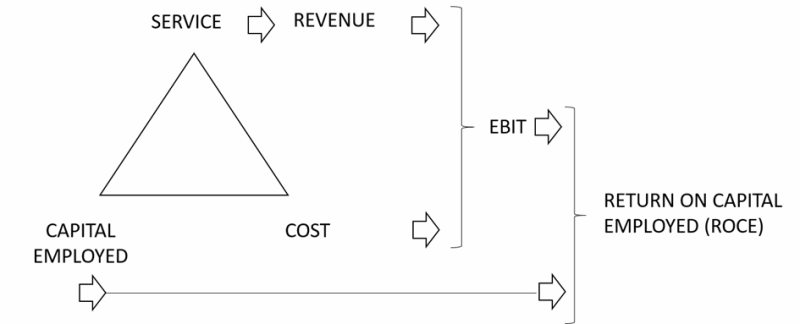Strategy-Driven Supply Chain Fundamentals: Supply Chain Triangle & ROCE

How do you start with supply chain planning and why is it so important?
Two fundamentals of the strategy-driven supply chain - the Supply Chain Triangle and the ROCE (Return on Capital Employed) metric - can help you to structure your business processes more thoroughly.
Balancing your supply chain triangle
Concept
One of the basics of the strategy-driven supply chain is that companies struggle to balance the triangle of service, cost and cash. This triangle is the framework to start from as it captures the struggle we regularly see in many companies between improving service, minimizing cost and reducing inventory (working capital).
Balancing this triangle is important because each side has influence on the others. For instance, improved services can lead to more sales, higher sales lead to lower inventory and a decreased inventory leads to less storage costs.
But why do we lack balance in the supply chain triangle? A lot of it has to do with the functional targets in different executive teams. In general, marketing and sales is more focused on the top-line and market share (service), production strives for efficiency and safety (cost), purchasing wants to buy more volume for lower cost, and finance is concerned about the free cash flow which goes to debt holders, banks and shareholders.

Practical use
From our experience with leading companies around the world, we use the triangle to raise awareness in a cross-functional team, representing every executive branch in the company.
In a joint effort, we draw the triangle and automatically, each role will fill in their own concerns on the different parts of the triangle. Through this exercise, we gather all the key challenges, get the debate started and eventually list options on how to drive improvements.
In the next phase, we also use the supply chain triangle to build and envision a concrete business case. How does supply chain planning improve the service, cost and cash side and what are the associated costs and benefits?
When the supply chain triangle has raised awareness and helped to envision the benefits of a strategy-driven supply chain, it’s time to design, implement and improve your business case. Solventure can help you break down bottom-line targets, tie in sustainability targets, define different levels (executive, regional or local) and build dashboards for a clear visual overview.
Analyzing your metrics with ROCE and benchmarking
Concept
Balancing the supply chain triangle is not optional, but mandatory to achieve all these objectives and optimize the value of your supply chain. This value we calculate using the ROCE metric, or Return on Capital Employed, which depicts the margin (service minus costs) over the invested capital, and is one of the fundaments of our strategy-driven thinking.
This key financial metric is instrumental for benchmarking and comparing your own supply chain with your direct competition. It gives you a broader perspective than, for instance, gross margin or EBIT (earnings before interest and taxes) and incorporates working capital metrics and asset efficiency.
Practical use
The easier access is to data, the more frequent we will benchmark against key competitors, because active benchmarking is a continuous and relevant process. By choosing one- or two-dimensional benchmarks, you can define your business case more solidly.

Using this comparative data, and by updating yours frequently, it will give you the tools to drive change in your supply chain. You can even compare quarterly data with competitors to always be on top of any sudden changes.
Crucial cornerstones of the strategy-driven supply chain
Both the Supply Chain Triangle and the ROCE metric are strategically crucial to build your S&OP business case. They convince all the executive decision makers in your company – each with their own goals and targets – of the importance of thoroughly planning your supply chain processes.




